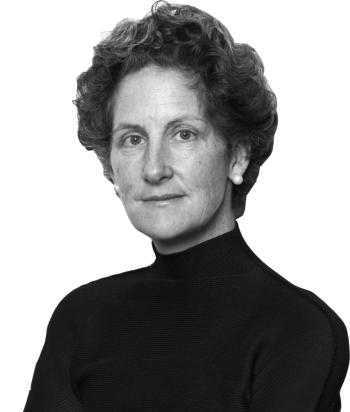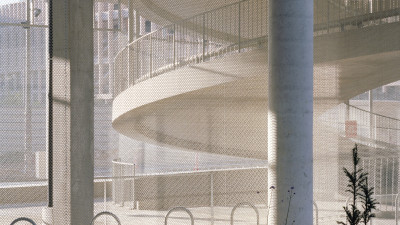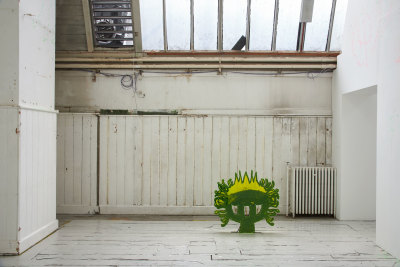“I’m hoping that lockdown will force a rethink of state expenditure on the public realm.”
Artists in Isolation
By Louisa Hutton RA
Published 23 April 2020

“I’m hoping that lockdown will force a rethink of state expenditure on the public realm.”
Our latest ‘Artist in Isolation’ column comes to you from Berlin, where architect Louisa Hutton RA lives with her husband and business partner, Matthias Sauerbruch. She shares the experience of running a practice in lockdown, and, despite it all, hopes for the fundamental good that could emerge from this crisis.
-
Now coming to the end of our first six weeks in self-isolation one finds oneself reluctantly getting used to the eery beauty of Berlin’s empty, and largely quiet, streets. Apart from next to no traffic, construction works have largely stopped – only infrastructural works continue like the construction of a pedestrian bridge over the nearby canal. Or isolated gardeners concentratedly weeding the forecourts of resolutely closed public buildings.
I have great unease with the noticeable police presence both on the streets and in the parks, checking that no more than two people are together and that they maintain, of course, the required social distance. I have just heard that a friend of ours in Milan is due to go to court for sitting on a public bench… Such control of urban space is of course decidedly not what the city should be about – and as nearly all of our work concerns the city in some way or other, it is particularly ironic that we are designing from a position of isolation, as from a retreat of kinds.
So nearly everybody from our office is working from home – the only exceptions being some dedicated modelmakers, our receptionist (on rotation) and the occasional other soul who either prefers to work from a near-empty office space than at home with his or her family, or someone who is involved in a competition deadline and who therefore needs to see large, printed out drawings – mistakes being nigh impossible to detect in the beguiling perfection of the screened image. Matthias and I have the advantage that we live very close to the office – so we drop in from time to time to say hello to these stalwarts or to have carefully-choreographed-and-socially-distanced meetings.
We are in the fortunate position that most of our projects, for the moment at least, are continuing to go ahead, if somewhat decelerated. A friend made the analogy recently that if one’s architectural project, when compared to a trans-Atlantic flight, was already mid-Atlantic at the time of the outbreak, then the chances are that it will carry on as planned. If, however, the pilot has just taken off, then one will most likely return to base with all the uncertainties of a cancelled flight. If one is still waiting at the gate, then: no chance. Currently, most of our current projects happen to be in the planning phases – at the time of the outbreak we had only one or two construction sites running. We have just heard that one in Geneva, for Médecins sans Frontières, that had been brought to a halt just four days after having started, has now re-opened – albeit, of course, with careful measures being taken…
Apart from our occasional forays into the office, communication between ourselves and the various office teams – as well as clients and consultants – is done almost exclusively via video conferencing. This means that there are endless meetings, often back-to-back, with little time for one’s own thinking that as a consequence has to be done in the evenings and over the week-ends – but this is in fact nothing new for us in the 30 years of our practice.
-
Huge existential questions and doubts dog me in this uncanny state of suspension. I grab onto any article whose author postulates that the post-corona world will be a better place than where we were beforehand.
-
Recently we held an office Pecha Kucha session – where each presenter shows 20 slides for 20 seconds each – with 65 participants and this, together with Matthias’ weekly newsletters, greatly help foster a spirit of cohesion and solidarity. As quite apart from the frustrations and inefficiencies that the enforced home-office situation brings, I hugely miss the daily informal contact that one has both on the social level as well as that regarding the making of architecture. One of the huge differences between the production of art and architecture must be that the latter is fundamentally team-work in which a seemingly endless series of discussions are held over literally every aspect of a project or a building. These are essentially iterative and it is during the ping-pong nature of such dialogues that ideas are both formed and sharpened. While this, at least in theory, can be achieved during a Zoom conference – the primitive sketches that can be made on the shared screen recalling the wobbly stepped lines of my childhood ‘Etchasketch’ – I am in no doubt that an actual physical meeting is highly superior and now after nearly six weeks of teleconferencing my patience is indeed running a little low…
Berlin’s spring sunshine leavens my mood – though its inherent optimism seems totally misplaced. Wouldn’t the Corona lockdown have felt more appropriate under the city’s grey skies? And I find myself more grateful than usual to discover inadvertent beauty in simple things such as reflections with their enjoyably disorienting ambiguities.
But such distractions, although welcome, cannot begin to compensate for the huge existential questions and doubts that dog me in this uncanny state of suspension. I grab onto any article whose author postulates that the post-corona world will be a better place than where we were beforehand, such as this one, from some weeks ago now, by futurologist, Matthias Horx.
Thinking such as this brings the hope that the change enforced by lockdown may also act as catalyst to ease other reforms long overdue, or that it may at least generate a new appreciation for the asset of the city and its public spaces that enrich (if not define) our collective and individual existences so decidedly.
In this of course architecture has a pioneering role to play, and we hope for a new generosity towards the community from both public and private clients, that places values other than monetary ones at the forefront of their endeavours.



